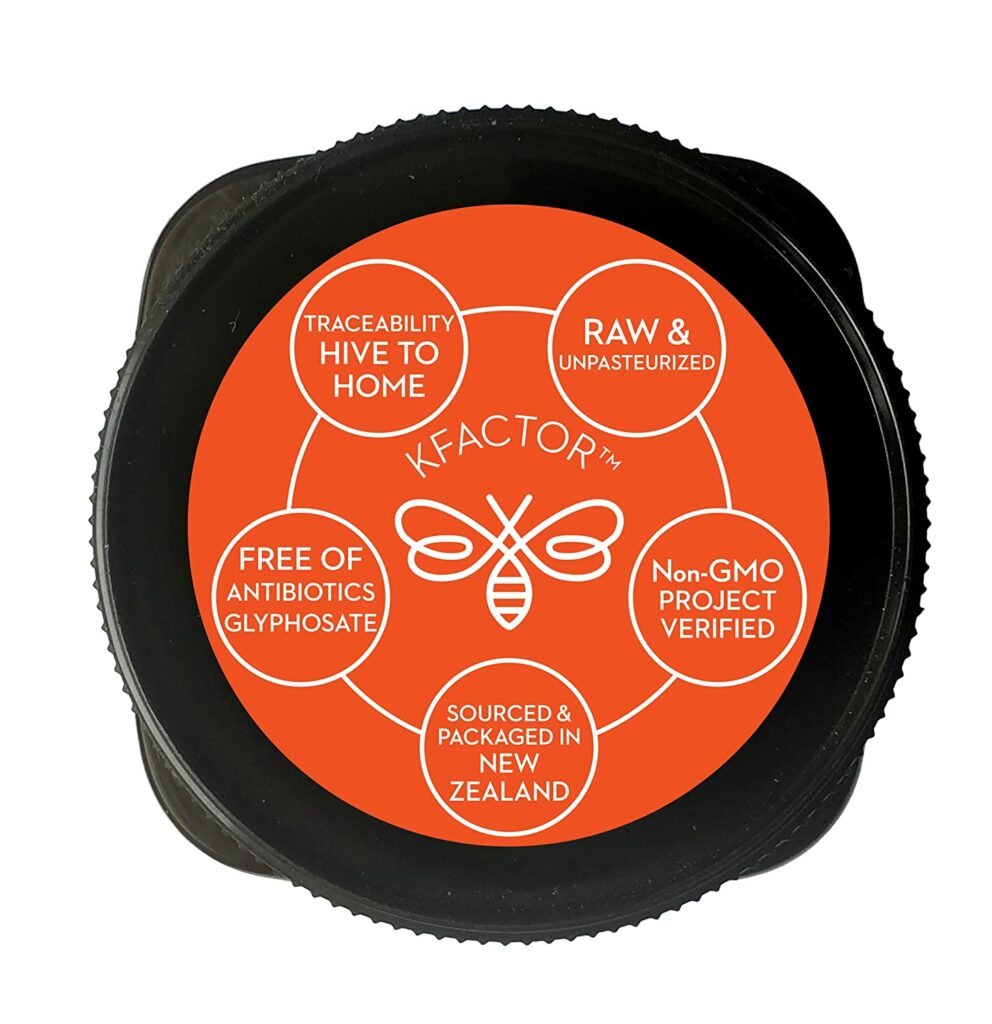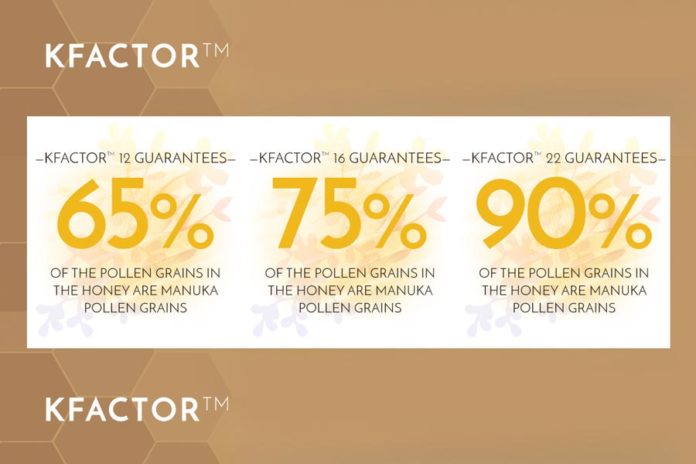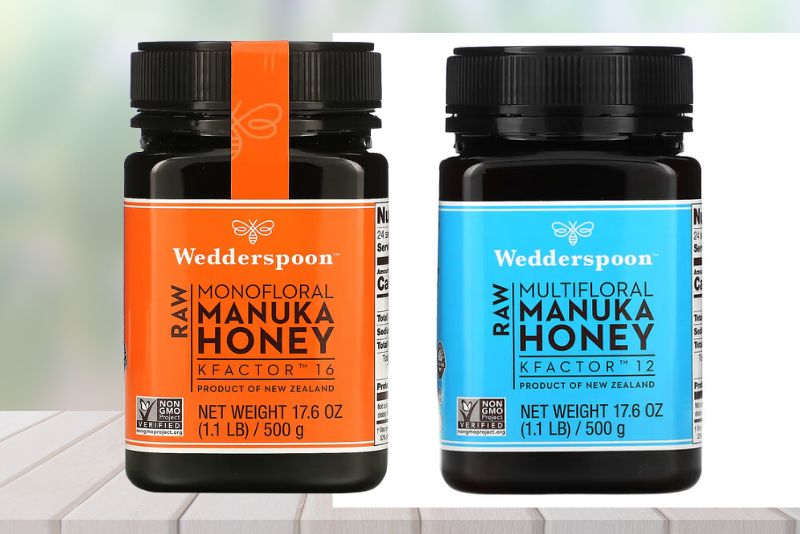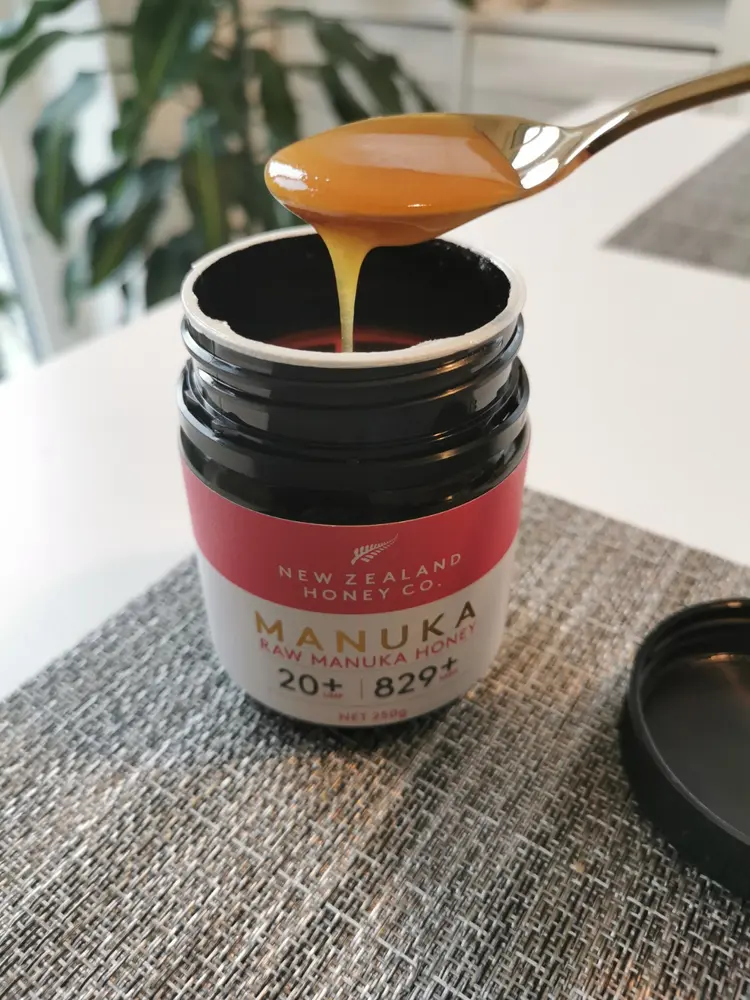If you’re going to buy manuka honey, you’ll want to get an authentic product. Otherwise, you’re going to waste your money. The K-factor can help confirm that you’re getting authentic manuka honey.
The rating measures the overall pollen count as well as the amount of manuka pollen in the honey. If there is no manuka pollen, the product is not real manuka honey.
Table of Contents
What Is K Factor In Manuka Honey?
What is the K-factor in manuka honey? Before purchasing any manuka honey, learn more about this measurement so you can ensure that you’re buying an authentic, high-quality product.
The k-factor is a measurement of the pollen in the honey. Plus, it can go beyond this level by specifying the manuka pollen portion.
One thing to note is that K-factor ratings are not available from all brands. Instead, the system was concocted by Wedderspoon.
This company is the primary user of the system so you may not find a K-factor rating when buying honey from another manufacturer.
Who Uses The K-Factor System?

Not many companies use the K-factor system. In some senses, it isn’t necessary. Nevertheless, checking the K-factor rating can give the customer peace of mind.
The only company that regularly uses K-factor is Wedderspoon which also made the system. The grading system is used to confirm the purity of the honey.
It does this by measuring the pollen in the manuka honey. Once the pollen is studied, the company will know how much manuka pollen is present.
What Does The K-Factor Do?
Unfortunately, the K-factor rating is limited. It doesn’t try to determine how potent your manuka honey will be. Instead, it focuses on the purity of the product.
In the future, Wedderspoon will begin measuring MGO levels and other characteristics as well. Using the K-factor system allows the company to measure the pollen in a bottle of manuka honey.
The system isn’t great because it doesn’t measure the potency of the honey, but it can confirm that you’re buying authentic manuka honey.
The Grades

There are three primary grades of K-factor manuka honey. They include K-Factor 12, K-Factor 16, and K-Factor 22.
Although this is similar to other grading systems, the number refers to the amount of pollen in the honey. The test is used to determine what percentage of the pollen is manuka pollen.
The system is odd and slightly confusing. After all, a K-factor of 12 means that 65% of the pollen is manuka pollen. If the honey has a K-factor rating of 22, 90% of the pollen is manuka pollen.
Some will argue that the company used this system as a way to mislead customers, but this statement is unfounded.
Is The K-Factor Beneficial?
Should customers take advantage of the K-factor when attempting to purchase high-quality manuka honey? Ultimately, the number shouldn’t be ignored if you’re buying manuka honey from Wedderspoon.
However, it may not be a good idea to go out of your way to try to identify this rating. After all, this isn’t a fully reliable system.
The primary problem is that manuka pollen is not unique. Instead, the plant produces pollen that is identical to other species including the Kanuka tree.
Unfortunately, this means that you could be getting manuka honey or kanuka honey. Kanuka honey and manuka have a similar taste so you may not notice the difference.
However, you won’t receive any medicinal benefits because kanuka honey doesn’t possess the same NPA properties as manuka honey.
What Are Better Than K-Factor Ratings?
The K-factor rating isn’t very useful because it doesn’t tell the customer must about the manuka honey. What is K factor in manuka honey?
The rating measures the pollen and the manuka pollen content. Although this is one thing to consider, it is probably the least important.
Instead, there are more important characteristics to consider when buying manuka honey. First, customers should make sure they’re buying manuka honey that has been UMF certified.
UMF stands for Unique Manuka Factor. The system is managed by the Unique Manuka Factor Honey Association.
This group plays an important role in governing the industry and ensures that potential troublemakers are kept out. It does this by testing and certifying manuka honey.
If you’re buying UMF-certified manuka honey, you can rest comfortably knowing that you’re getting an authentic product.
If the product isn’t certified, it may not be manuka honey at all. Ultimately, it is never wise to buy any honey that isn’t certified.
Finally, the MGO rating is also more important than the K-factor rating.
Comparing K-Factor To MGO & UMF
There are major differences between the K-factor and the other grading systems. The K-factor system primarily refers to the manuka pollen count in the honey.
It may be possible to authenticate the manuka in the honey using this system, but the results aren’t guaranteed. On the other hand, MGO and UMF systems check other characteristics.
The MGO test is interested in finding out how much Methylglyoxal is present in the manuka honey. Methylglyoxal is important because it is the active ingredient in manuka honey.
If the honey has a higher concentration of Methylglyoxal, it’ll be more potent and better for medicinal purposes. The UMF system is more comprehensive and more beneficial.
It tests the manuka honey for several things including the MGO content. The UMF system is used by the UMF Honey Association.
It checks the non-peroxide activity, MGO content, and more.
Where To Find The K-Factor Rating?
Most companies do not use the K-factor rating system. In some ways, it is unnecessary when the UMF system is used.
While the K-factor rating checks the pollen, the UMF rating checks so much more. Still, you may encounter a K-factor rating when attempting to choose a manuka honey product.
Typically, Wedderspoon is the only company that uses this system regularly. Other companies use UMF or MGO. While the system isn’t perfect, it is one thing that sets Wedderspoon apart from its competitors.
What is k factor in manuka honey? It specifies the manuka pollen content in the honey.
Where can you find the k-factor rating? When you look at a bottle of Wedderspoon manuka honey, you should see the K-Factor on the bottle.
The rating should be clearly displayed. Furthermore, the rating is available on the company’s website.
You can find it in the name of the product and the description. It should say “KFACTOR 16” or something similar.
Again, most competitors do not use this rating. Although it can be helpful, it probably isn’t a good idea to depend solely on the K-factor because it is so limited.
Frequently Asked Questions
Is The K-Factor System Reliable?
Unfortunately, the K-factor system is not reliable. It is used to check the manuka pollen content in the honey. The only problem is that manuka pollen isn’t unique because it is identical to pollen from other species. Therefore, the test isn’t reliable.
Can The K-Factor Rating Be Ignored?
The K-factor rating is probably unhelpful unless you’re buying manuka honey from Wedderspoon. It is always better to rely on UMF testing because it is more comprehensive, reliable, and helpful.
Is Wedderspoon The Only Company That Uses It?
Wedderspoon seems to be the only company that uses the K-factor grading system. After all, it made the system and continues using it to this day. Other companies prefer UMF or MGO testing.

